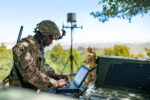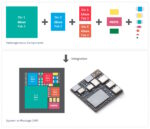Radial flux AC motors offer some performance and packaging benefits but also bring some thermal and manufacturability issues. This part of the FAQ continues the exploration of AFMs and RFMs. The first part examined the axial-flux motor (AFM) in more detail and compared it to the very widely used radial-flux motor (RFM). The final part […]
FAQ
What is the best copper alloy for connectors in renewable energy and EV applications?
Copper is important in supporting renewable energy and electric vehicles (EVs). For example, there’s about 5.5 tons of copper used per megawatt (MW) of photovoltaic generation and there’s 183 pounds of copper in an EV, compared with only 48 pounds in an internal combustion engine (IEC) vehicle. Not all copper is the same; there’s a […]
What are the key design and selection considerations for MIL-SPEC connectors?
MIL-SPEC connectors are designed to operate reliably in challenging conditions and extreme environments. First developed in the 1930s for the US Armed Forces, military standard connectors are now used across multiple industries, from energy and aerospace to maritime and automotive. This article discusses key MIL-SPEC connector design requirements and reviews crucial connector selection criteria. It […]
FAQ on axial flux motors: Part 1
Radial flux AC motors offer some performance and packaging benefits but also bring some thermal and manufacturability issues. For many electrical and even mechanical engineers, motor selection is somewhat of a mysterious process. You can understand their basic principles and operation. Still, the real-world design considerations of their flux paths, poles, materials, and tradeoffs seems […]
What are the challenges when testing chiplets?
Chiplet testing begins with performance simulations during the design process. Compared with monolithic devices, heterogeneous chiplets require more complex testing, including known good die (KGD) testing, final test, and system level test. Success also depends on the implementation of design for test (DfT) based on several IEEE standards. Chiplet designers need high-speed tools that can […]
How can in-package optical interconnects enhance chiplet generative AI performance?
Generative artificial intelligence (AI) requires rapid and continuous movement of large amounts of data. In a growing number of instances, electrical input/output (I/O) connections between the ICs in chiplets are becoming a bottleneck to higher performance. Key electrical I/O performance barriers include power efficiency, bandwidth, and latency. This FAQ looks at the anticipated benefits of […]
How can carbon nanotubes improve interconnect performance?
Carbon nanotubes (CNTs) have been proposed for reducing fretting wear in connectors used in high-vibration environments like vehicles. They can also be used to make contacts with lower contact resistance and higher corrosion resistance compared with silver (Ag) plating, and they have been used to reduce the weight in some shielded cables by 25% or […]
Delivering power supply reliability in mission-critical systems
There are several factors to consider when selecting a power supply that delivers the high voltages often needed by large and complex high-performance systems. For almost all electronic products and systems, high reliability should be expected. Still, in some markets, reliability cannot be compromised or a trade-off for other performance factors. In particular, mission-critical industrial […]
How do UCIe and BoW interconnects support generative AI on chiplets?
The bunch-of-wires (BoW) and Universal Chiplet Interconnect Express (UCIe) standards provide designers with tradeoffs in terms of throughput, interconnect density, delay, and bump pitch. This FAQ compares the performance of BoW and UCIe and looks at how optical interconnects may provide a path to even higher performance interconnects in chiplets. To realize optimal performance for […]
What is the heterogeneous integration roadmap, and how does it support generative AI?
The heterogeneous integration roadmap (HIR) is an ongoing initiative of the IEEE Electronics Packaging Society. It’s a living document that continues to evolve and expand in response to technological developments like the growth of generative artificial intelligence (AI) and quantum computing. This FAQ starts with a brief overview of heterogeneous integration, looks at the scope […]











